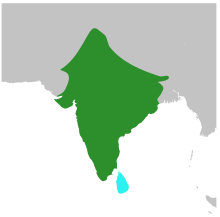வரி வாலாட்டிக் குருவி
| வரி வாலாட்டிக் குருவி | |
|---|---|

| |
| உயிரியல் வகைப்பாடு | |
| திணை: | |
| தொகுதி: | |
| வகுப்பு: | |
| வரிசை: | |
| குடும்பம்: | மோட்டாசிலிடே
|
| பேரினம்: | மோட்டாசிலா
|
| இனம்: | மோ. மெட்ராசுபடென்சிசு
|
| இருசொற் பெயரீடு | |
| மோட்டாசிலா மெட்ராசுபடென்சிசு ஜிமெலின், 1789 | |

| |
| வேறு பெயர்கள் | |
|
மோட்டாசிலா மெட்ராசுபாடென்சிசு | |
வரி வாலாட்டிக் குருவி (white-browed wagtail) அல்லது வெண்புருவ வாலாட்டி[5] என்பது இந்தியாவில் காணப்படும் ஒரே ஒரு இடம் பெயரா வாலாட்டிக் குருவி ஆகும்.
விளக்கம்[தொகு]
இதன் உடலின் மேலே கருப்பு மற்றும் கீழே வெள்ளையுடன், வெள்ளை புருவமும், தோள்பட்டை மற்றும் வெளிப்புற வால் இறகுகள் ஆகியவற்றுடன் இவை தெளிவாக வடிவமைக்கப்பட்டுள்ளன. வெள்ளை-புருவம் கொண்ட வாலாட்டிகள் தெற்காசியாவை பூர்வீகமாகக் கொண்டவை. சிறிய நீர்நிலைகளுக்கு அருகில் பொதுவாக காணப்படுகின்றன. மேலும் நகர்ப்புற சூழலுக்கு ஏற்றவாறு இவை பெரும்பாலும் கூரையின் மேல் கூடு கட்டுகின்றன. இதனுடைய சிற்றினப் பெயரானது இந்திய நகரமான மெட்ராஸிலிருந்து (இப்போது சென்னை) பெறப்பட்டது.
இதனுடைய உடல் நீளம் 21 செ. மீ. வரை இருக்கும். இது ஒரு மெலிந்த பறவை. இந்த இனப்பறவைகள் நீண்ட வாலிறகையும், அதனைத் தொடர்ந்து ஆட்டும் பண்பினையும் கொண்டது. இது வெள்ளை வாலாட்டிப் போல், நெற்றியில் வெண்மையாக இருக்காது. ஆனால் மீதமுள்ள அடிப்பகுதி வெண்மையானது.[6][7][8]
நடத்தை[தொகு]
பொதுவாக நீர்நிலைகளுக்கருகில் இணைகளாகவோ அல்லது சிறு குழுக்களாகவோ காணப்படும். இவை குறிப்பாக காலை நேரங்களில் அடிக்கடி ஓசை எழுப்பும்.[9] பிற வாலாட்டிகளைப் போல சுறுசுறுப்பாக இருக்கும். இவை தரையிலும், கம்பிகளிலும் அல்லது கட்டிடங்களிலும் அமர்ந்திருக்கும். பாடல் நீண்ட மற்றும் பலவிதமான ஒலிக் குறிப்புகளுடன் சத்தமாக உள்ளது. வழக்கமான "வீச்" என்று அழைக்கப்படும்.[6] இவை நீண்ட தூரங்களுக்கு மிக வேகமாகப் பறக்க கூடியன. மேலும் இவை மணிக்கு 40 கி. மீ. வேகத்தில் பயணிக்கும் வகையில் பறப்பது பதிவு செய்யப்பட்டுள்ளன.[10] புற ஒட்டுண்ணிகள் இந்த பறவைகளில் காணப்பட்டது பதிவு செய்யப்பட்டுள்ளன.[11]
இனப்பெருக்கம்[தொகு]

இதன் இனப்பெருக்க காலம் மார்ச் முதல் அக்டோபர் வரை ஆகும்.[6] தென்னிந்தியாவில், ஆறுகளின் நீர்மட்டம் குறைந்து பருவமழை பெய்யும் வரை கூடு கட்டும் காலம் தொடங்குகிறது.[12]
உணவு[தொகு]
மற்ற வாலாட்டிகள் போல, இந்த சிற்றினமும் பூச்சிகளை உண்ணக்கூடியது. குஞ்சுகளுக்கு முக்கியமாக ஆர்த்தோப்டிரான்கள், கம்பளிப்பூச்சிகள் மற்றும் சிலந்திகளை உணவாக அளிக்கின்றன.[13] இசுடேபிலினிட் வண்டுகள் மற்றும் பெண்டாட்டோமிட் வண்டுகளும் இவற்றின் உணவுத் தேர்வாகப் பதிவு செய்யப்பட்டுள்ளன.[14] கூண்டுகளில் வீடுகளில் வளர்க்கப்படும் நிலையில் இவை வளைத்தசைப் புழுக்களை உண்ணுகின்றன.[15] இவை நகர்ப்புற சூழலுக்கு ஏற்றவாறு, சேமிப்பு தொட்டிகளிலிருந்து நிரம்பி வழியும் நீர் மற்றும் கூரைகளில் காணப்படலாம்.[16]
கலாச்சாரத்தில்[தொகு]
இந்தியாவில் பண்டைய காலங்களில், இந்த சிற்றினம் கூண்டு-பறவையாக வளர்க்கப்பட்டது. இதன் ஓசைக்காக பாராட்டப்பட்டது. அழகான கண்களைக் கொண்ட ஒருவரை விவரிக்க "கஞ்சன்-கண்கள்" என்ற சொற்றொடரில் கஞ்சன் என்றப் பெயர் பயன்படுத்தப்படுகிறது.[17] கஞ்சன் புனிதமானதாகக் கருதப்பட்டது மற்றும் இந்தியாவில் இதன் மார்பில் விசுணுவின் சாலிகிராம் போன்ற தோற்றத்தைக் கொண்டிருப்பதால் இதனை காண்பதை நல்ல சகுனமாகக் கருதினர்.[18] இந்தப் பறவை எங்கு அமர்ந்து இருந்தாலும் மற்றும் அது என்ன செய்கிறது என்பதன் மூலம் எதிர்காலம் பற்றிய பல்வேறு நம்பிக்கைகள் சரத்சந்திர மித்ராவால் ஆவணப்படுத்தப்பட்டுள்ளன.[19] இந்தியாவில் வாலாட்டிகளுக்கு வழங்கப்படும் மற்றொரு உள்ளூர் பெயர் தோபின் (துணி துவைக்கும் பெண்) என்பதாகும்.[20]
மேற்கோள்கள்[தொகு]
- ↑ BirdLife International. 2012. Motacilla madaraspatensis. In: IUCN 2012. IUCN Red List of Threatened Species. Version 2012.2. Downloaded on 3 June 2013.
- ↑ Jerdon,TC (1840). "Catalogue of the birds of the peninsula of India, arranged according to the modern system of classification; with brief notes on their habits and geographical distribution, and description of new, doubtful and imperfectly described specimens". Madras Jour. Lit. Sc. 11: 1–38. http://www.archive.org/stream/madrasjournalli00browgoog#page/n24/mode/1up.
- ↑ Blyth, Edward (1819). Catalogue of the birds in the Museum Asiatic Society. The Asiatic Society. பக். 137. http://www.archive.org/stream/catalogueofbirds00asia#page/136/mode/1up.
- ↑ Stephens, JF (1817). General zoology. Volume 10. Part 2. Birds. Privately published, London. பக். 548. http://www.archive.org/stream/p2generalzoology10shawuoft#page/548/mode/1up/.
- ↑ [1]
- ↑ 6.0 6.1 6.2 Rasmussen, PC; JC Anderton (2005). Birds of South Asia: The Ripley Guide. Volume 2. Smithsonian Institution & Lynx Edicions. பக். 315.
- ↑ Oates, EW (1890). The Fauna of British India, Including Ceylon and Burma. Birds. 2. Taylor and Francis, London. பக். 291–293. https://archive.org/stream/faunaofbritishin02oate#page/291/mode/1up/.
- ↑ Whistler, Hugh (1949). Popular handbook of Indian birds (4 ). Gurney and Jackson, London. பக். 245–246. பன்னாட்டுத் தரப்புத்தக எண்:1-4067-4576-6. https://archive.org/stream/popularhandbooko033226mbp#page/n292/mode/1up/.
- ↑ Newnham, A (1898). "The Large Pied Wagtail Motacilla maderaspatensis in captivity". J. Bombay Nat. Hist. Soc. 11 (3): 535–536. https://biodiversitylibrary.org/page/30157293.
- ↑ Acharya, H.N. (1933). "Speed of the Large Pied Wagtail Motacilla maderaspatensis (Gmelin)". J. Bombay Nat. Hist. Soc. 36 (4): 996–997. https://biodiversitylibrary.org/page/48291912.
- ↑ Sultana, A (1962). "New Species of Chandlerella Yorke and Maplestone, 1926, and Splendidofilaria Skrjabin, 1923, from Indian Birds, with a Discussion of Related Genera". Journal of Parasitology 48 (5): 707–714. doi:10.2307/3275259. https://archive.org/details/sim_journal-of-parasitology_1962-10_48_5/page/707.
- ↑ Ali, S; S D Ripley (1998). Handbook of the birds of India and Pakistan. 9 (2 ). Oxford University Press. பக். 300–302. பன்னாட்டுத் தரப்புத்தக எண்:0-19-562063-1.
- ↑ Verzhutskii, Boris (2002). "Diet of the Large Pied Wagtail Motacilla maderaspatensis in Auroville, Pondicherry". Zoos' Print Journal 17 (9): 886. doi:10.11609/jott.zpj.17.9.886.
- ↑ D'Abreu, E A (1920). "Some insect prey of birds in the Central Provinces". Proceedings of the Third Entomological Meeting Held at Pusa on the 3rd to 15th February 1919. 3. Superintendent Government Printing, Calcutta. பக். 859–871. https://archive.org/stream/reportofprocee03ento#page/859/mode/1up.
- ↑ Mason, CW; edited by Maxwell-Lefroy, H (1912). "The food of birds in India". Memoirs of the Department of Agriculture in India, Entomological Series 3: 1–371. https://archive.org/stream/memoirsentomolog03impeuoft#page/n327/mode/2up/.
- ↑ Bell, D.A. (1986). "An unusual nest site for the Large Pied Wagtail". Newsletter for Birdwatchers 26 (7&8): 11–12. https://archive.org/stream/NLBW26#page/n81/mode/1up.
- ↑ Law, Satya Churn (1923). Pet birds of Bengal. 1. Thacker, Spink & Co. பக். 240–264. https://archive.org/stream/petbirdsofbengal00laws#page/240/mode/2up.
- ↑ "The Khunjunee". Chambers' Edinburgh Journal (441): 384. 1852. https://www.gutenberg.org/files/24892/24892-h/24892-h.htm#THE_KHUNJUNEE.
- ↑ Mitra, Carat Chandra (1898). "Bengali and Behari Folk-lore about Birds. Part I.". Journal of the Asiatic Society of Bengal. Part III 67 (2): 67-74.
- ↑ Finn, Frank (1906). Garden and aviary birds of India. Thacker and Spink. பக். 106–107. https://archive.org/stream/gardenaviarybird00fin#page/107/mode/1up/.
பிற மூலங்கள்[தொகு]
- Hussain, T., Ghafoor, A., Qureshi, J.I. (1989) Food habits of large pied wagtail (Motacilla maderaspatensis) . Pakistan Journal of Agricultural Sciences 26(4):426–431
- Patel, ST; Pilo, B; Shah, RV (1977) Oxidative metabolism in the liver and kidney of migratory Starling (Sturnus roseus) and Wagtail (Motacilla alba). Pavo 14(1&2):41–49.
- Chanda, S (1998): Courtship display of Large Pied Wagtail Motacilla maderaspatensis in Kokrajhar, Assam. Newsletter for Birdwatchers . 38(5):88.


